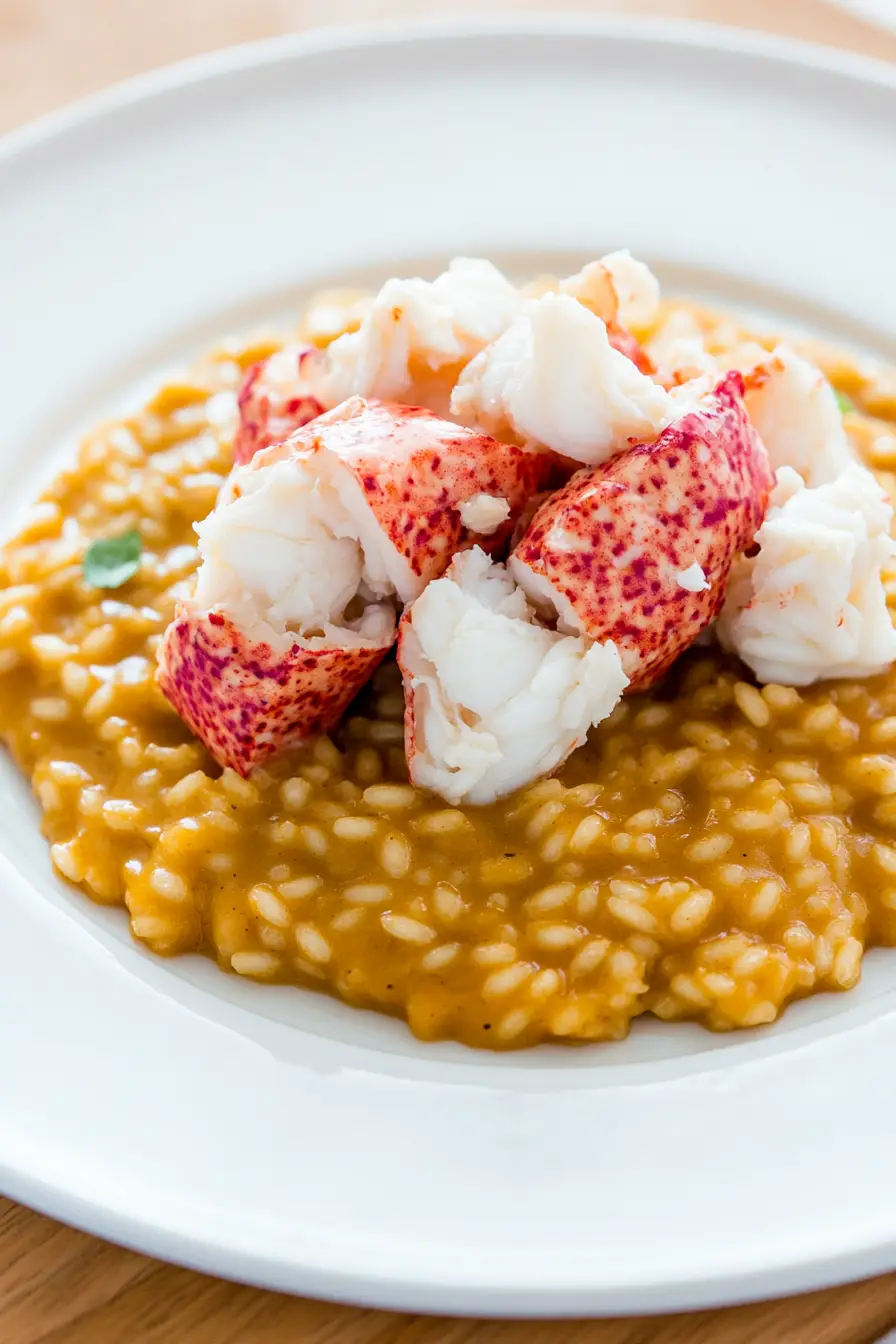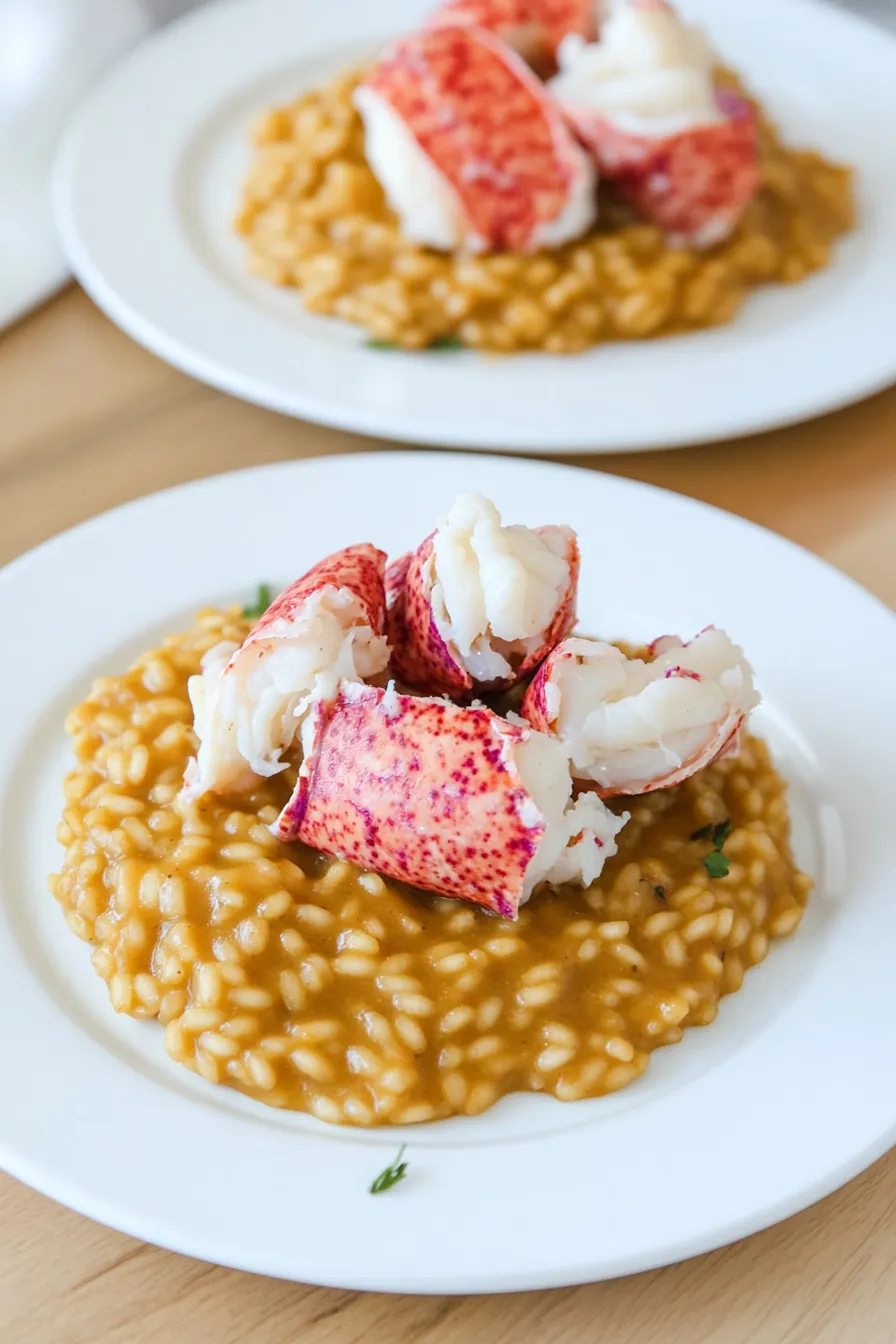I never thought I’d combine two of my favorite dishes until I ran out of options one night. There was some leftover lobster bisque in the fridge and arborio rice in the pantry, and my usual dinner plans had fallen through.
Turns out, mixing lobster bisque into risotto instead of using plain broth is one of those happy accidents that just makes sense. The creamy soup adds richness to the rice that regular stock just can’t match. And the best part? It’s actually easier than making traditional risotto because half the flavoring work is already done for you.

Why You’ll Love This Lobster Bisque Risotto
- Restaurant-quality dish – This combination of creamy risotto and rich lobster bisque creates a dish that tastes like it’s straight from a high-end Italian restaurant, but you can make it right in your kitchen.
- Two-in-one recipe – You’re not just making risotto – you’re creating a flavorful lobster bisque that gets incorporated into the rice, making every bite packed with seafood flavor.
- Perfect for special occasions – This recipe is ideal for date nights, anniversaries, or when you want to impress dinner guests with something extra special.
- Made from scratch – Using fresh lobsters and making your own stock ensures the most authentic and rich flavor – no artificial ingredients or pre-made bases needed.
What Kind of Rice Should I Use?
For risotto, you’ll want to stick with Italian short-grain rice varieties that are high in starch. Carnaroli is often called the “king of rices” for risotto because it’s really good at absorbing liquid while still keeping its shape and has a nice, creamy result. If you can’t find carnaroli, Arborio rice is more commonly available in grocery stores and works well too. Vialone Nano is another good option – it’s traditionally used in Venice and creates an extra creamy texture. Just don’t try to substitute regular long-grain rice or sushi rice, as these won’t give you that classic risotto texture we’re looking for.

Options for Substitutions
While some ingredients in this recipe are essential, there are a few swaps you can make if needed:
- Lobster: Fresh lobster is key here, but in a pinch, you could use pre-cooked lobster meat. Just skip the cooking steps and add the meat at the end. Keep in mind the flavor won’t be as rich since you won’t have the shells for the stock.
- Carnaroli rice: This is one ingredient you shouldn’t substitute – risotto rice varieties like carnaroli or arborio are essential for the creamy texture. Regular rice won’t give you the same results.
- White wine: If you don’t use alcohol, replace the wine with the same amount of chicken stock plus 1 tablespoon of lemon juice for that acidic note.
- Shallot: No shallots? Use an extra 1/4 cup of finely minced onion instead.
- Fresh herbs: If you can’t find fresh thyme, use 1/2 teaspoon dried thyme. For parsley, dried isn’t a great substitute – you can skip it or use fresh chives instead.
- Tomato paste: You can swap this with the same amount of sundried tomato puree, though regular tomato paste gives the best color and flavor.
Watch Out for These Mistakes While Cooking
The biggest challenge when making lobster bisque risotto is rushing the cooking process – risotto needs constant attention and slow stirring to release its starches, which typically takes about 18-20 minutes. A common error is adding too much liquid at once, so add your hot stock gradually, one ladle at a time, waiting until each addition is absorbed before adding more. When cooking the lobster, timing is crucial – overcooking will make the meat tough and rubbery, so remove the lobster from the pot as soon as the shell turns bright red and the meat becomes opaque (usually 7-8 minutes for whole lobsters). For the creamiest results, keep your stock at a gentle simmer throughout the cooking process, and don’t forget to finish your risotto with a final pat of butter and let it rest for 2 minutes before serving – this final step, called “mantecatura,” creates that perfect silky texture.

What to Serve With Lobster Bisque Risotto?
Since lobster bisque risotto is such a rich and filling main dish, it’s best to keep the sides simple and light. A fresh arugula salad with lemon vinaigrette makes a perfect partner, cutting through the creamy richness of the risotto. You might also want to serve some crusty bread on the side – a slice of good sourdough or French baguette works great for soaking up any extra sauce. For a special touch, add some roasted asparagus or steamed green beans tossed with a bit of olive oil and sea salt – these green veggies add nice color to the plate and balance out the meal.
Storage Instructions
Keep Fresh: This lobster bisque risotto is best enjoyed right after cooking, but if you have leftovers, place them in an airtight container in the fridge for up to 2 days. The risotto might thicken up a bit, but don’t worry – that’s totally normal!
Save: I don’t recommend freezing risotto as it can affect the creamy texture and the rice might become grainy. The lobster meat could also lose its tender texture when frozen and reheated.
Warm Up: To enjoy your leftover risotto, gently warm it in a pan over low heat, adding a splash of warm stock or water to help bring back its creamy consistency. Stir occasionally while heating to ensure even warming and prevent sticking to the bottom of the pan.
| Preparation Time | 20-30 minutes |
| Cooking Time | 30-45 minutes |
| Total Time | 50-75 minutes |
| Level of Difficulty | Medium |
Estimated Nutrition
Estimated nutrition for the whole recipe (without optional ingredients):
- Calories: 1200-1400
- Protein: 90-100 g
- Fat: 70-80 g
- Carbohydrates: 100-110 g
Ingredients
For the lobster:
- 2 live lobsters (1.5 lbs each, steamed or boiled)
For the stock and bisque base:
- a few sprigs fresh thyme
- 1/2 tsp whole black peppercorns
- 1 minced shallot (finely chopped for quick infusion)
- a bunch fresh parsley
- 2 tbsp olive oil (I use Colavita extra virgin)
- 1 bay leaf
- 1 chopped carrot (peeled and roughly chopped)
- 2 quarts water
- 1 chopped celery stalk
- 2 tsp tomato paste (concentrated for deep flavor)
- 1 chopped onion (roughly chopped)
For the risotto:
- 1/3 cup dry white wine (like Sauvignon Blanc or Pinot Grigio)
- 130 grams carnaroli rice (excellent for creamy risotto)
- freshly cracked black pepper (to taste)
- juice from a fresh lemon (brightens the dish)
- 3 tbsp butter, divided (I prefer Kerrygold unsalted butter)
- salt
Step 1: Prepare and Humanely Kill the Lobsters
Start by placing the lobsters in the freezer for about 10 minutes to make them drowsy and less active.
This humane step makes the process easier for both you and the lobsters.
After the freezing period, bring a large pot with 2 liters (2 quarts) of water to a boil.
Position the tip of a large chef knife on the ‘cross’ located on the head of each lobster.
Thrust the knife down and forward to quickly and humanely kill each lobster instantly.
Step 2: Segment the Lobsters and Prepare Tomalley
Separate each lobster into the tail, legs, claws, and body.
Carefully cut open the body, and remove the tomalley (the greenish substance), placing it in a bowl for later use if desired.
Discard the rest of the body contents to avoid any bitterness when using the stock.
Repeat this process for the second lobster and refrigerate the bowl with tomalley.
Step 3: Cook the Lobster Parts
Add the lobster tails, legs, and claws to the boiling water.
Bring it back to a boil and then turn off the heat.
If you are using sous-vide, remove the tails after 1 minute and plunge them into cold water to stop the cooking process.
Leave the claws and legs to steep in the hot water for about 7 more minutes, which allows them to cook thoroughly while retaining flavor.
Step 4: Extract the Meat from Lobster Tails
While the lobster claws and legs are steeping, focus on extracting the meat from the tails.
For small portions, cut each tail in half lengthwise to make it easier to access the meat.
Ensure you carefully separate the meat from the shell, keeping it intact as much as possible for future use or presentation.
Step 5: Assemble and Enjoy
Once all parts have been cooked and the meat extracted, you can use the lobster meat for your desired recipe.
Whether it’s for a classic lobster roll, a sumptuous pasta, or simply enjoyed with melted butter, make sure to relish the rich flavor of fresh lobster!

